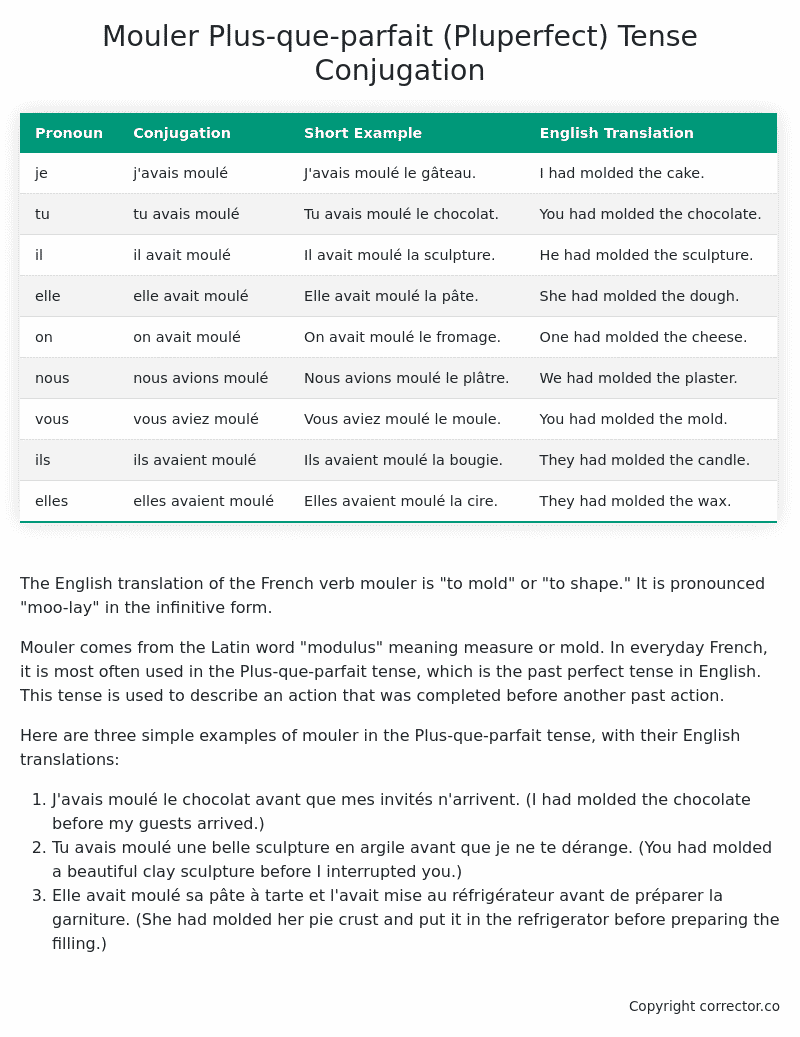Plus-que-parfait (Pluperfect) Tense Conjugation of the French Verb mouler
Introduction to the verb mouler
The English translation of the French verb mouler is “to mold” or “to shape.” It is pronounced “moo-lay” in the infinitive form.
Mouler comes from the Latin word “modulus” meaning measure or mold. In everyday French, it is most often used in the Plus-que-parfait tense, which is the past perfect tense in English. This tense is used to describe an action that was completed before another past action.
Here are three simple examples of mouler in the Plus-que-parfait tense, with their English translations:
- J’avais moulé le chocolat avant que mes invités n’arrivent. (I had molded the chocolate before my guests arrived.)
- Tu avais moulé une belle sculpture en argile avant que je ne te dérange. (You had molded a beautiful clay sculpture before I interrupted you.)
- Elle avait moulé sa pâte à tarte et l’avait mise au réfrigérateur avant de préparer la garniture. (She had molded her pie crust and put it in the refrigerator before preparing the filling.)
Table of the Plus-que-parfait (Pluperfect) Tense Conjugation of mouler
| Pronoun | Conjugation | Short Example | English Translation |
|---|---|---|---|
| je | j’avais moulé | J’avais moulé le gâteau. | I had molded the cake. |
| tu | tu avais moulé | Tu avais moulé le chocolat. | You had molded the chocolate. |
| il | il avait moulé | Il avait moulé la sculpture. | He had molded the sculpture. |
| elle | elle avait moulé | Elle avait moulé la pâte. | She had molded the dough. |
| on | on avait moulé | On avait moulé le fromage. | One had molded the cheese. |
| nous | nous avions moulé | Nous avions moulé le plâtre. | We had molded the plaster. |
| vous | vous aviez moulé | Vous aviez moulé le moule. | You had molded the mold. |
| ils | ils avaient moulé | Ils avaient moulé la bougie. | They had molded the candle. |
| elles | elles avaient moulé | Elles avaient moulé la cire. | They had molded the wax. |
Other Conjugations for Mouler.
Le Present (Present Tense) Conjugation of the French Verb mouler
Imparfait (Imperfect) Tense Conjugation of the French Verb mouler
Passé Simple (Simple Past) Tense Conjugation of the French Verb mouler
Passé Composé (Present Perfect) Tense Conjugation of the French Verb mouler
Futur Simple (Simple Future) Tense Conjugation of the French Verb mouler
Futur Proche (Near Future) Tense Conjugation of the French Verb mouler
Plus-que-parfait (Pluperfect) Tense Conjugation of the French Verb mouler (this article)
Passé Antérieur (Past Anterior) Tense Conjugation of the French Verb mouler
Futur Antérieur (Future Anterior) Tense Conjugation of the French Verb mouler
Subjonctif Présent (Subjunctive Present) Tense Conjugation of the French Verb mouler
Subjonctif Passé (Subjunctive Past) Tense Conjugation of the French Verb mouler
Subjonctif Imparfait (Subjunctive Imperfect) Tense Conjugation of the French Verb mouler
Subjonctif Plus-que-parfait (Subjunctive Pluperfect) Tense Conjugation of the French Verb mouler
Conditionnel Présent (Conditional Present) Tense Conjugation of the French Verb mouler
Conditionnel Passé (Conditional Past) Tense Conjugation of the French Verb mouler
L’impératif Présent (Imperative Present) Tense Conjugation of the French Verb mouler
L’infinitif Présent (Infinitive Present) Tense Conjugation of the French Verb mouler
Struggling with French verbs or the language in general? Why not use our free French Grammar Checker – no registration required!
Get a FREE Download Study Sheet of this Conjugation 🔥
Simply right click the image below, click “save image” and get your free reference for the mouler Plus-que-parfait tense conjugation!

Mouler – About the French Plus-que-parfait (Pluperfect) Tense
Tense Formation
Common everyday usage patterns
Sequencing of past events
Background information
Hypothetical or reported speech
Interactions with other tenses
Summary
I hope you enjoyed this article on the verb mouler. Still in a learning mood? Check out another TOTALLY random French verb conjugation!


